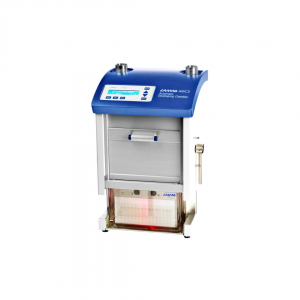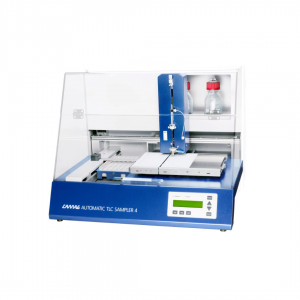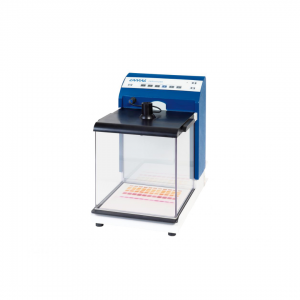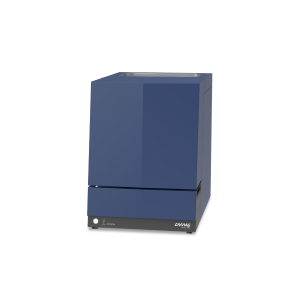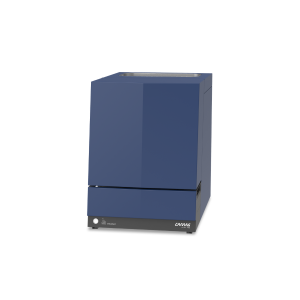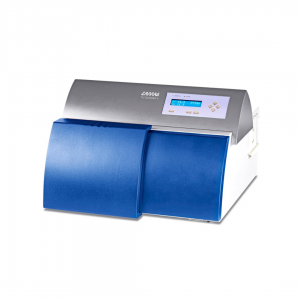-
Automatic Developing Chamber 2 (ADC2)
The ADC 2 offers convenience, safety, and reproducibility for isocratic developments of 20 x 10 cm HPTLC glass plates in full compliance with Ph. Eur. Chapter 2.8.25 and USP Chapter <203>.
The ADC 2 is a device for reproducible plate development. It performs the development step fully automated, and independent of environmental effects. The activity and pre-conditioning of the layer, chamber saturation, developing distance and final drying can be preset and automatically monitored by the ADC 2. Two modes of operation are possible: stand-alone with input of parameters via keypad, or remote operation from visionCATS with process monitoring, documentation of operating parameters, and reporting.
With visionCATS the ADC 2 can be IQ/OQ qualified and used in a cGMP environment. Operated with the mentioned software, the ADC 2 supports compliance with 21 CFR Part 11.
Key Features
- Fully automated development
- Development in 20 x 10 cm Twin Trough Chamber
- HPTLC plates (20 x 10 cm)
- Operation in stand-alone mode or software-controlled
- Fully traceable operation
- Option “Humidity Control” allows reproducible chromatography.
-
Automatic TLC Sampler 4 (ATS4)
The ATS 4 is a device for fully automated sample application onto TLC and HPTLC plates. Samples can be applied as bands, spots or rectangles.
Automatic sample application is a key factor for productivity of the HPTLC laboratory. The ATS 4 offers fully automatic sample application for qualitative and quantitative analyses as well as for preparative separations. It is suited for routine use and high sample throughput.
Key Features
- Fully automated sample application
- Application of bands, spots or rectangles
- Any plate format up to 20 x 20 cm
- Spray-on application or by contact transfer
- Software-controlled by visionCATS
- Heated Spray Nozzle (option)
-
Derivatizer
Automated spraying device for reagent transfer onto TLC/HPTLC plates.
The Derivatizer is used for automated reagent transfer in the derivatization of thin-layer chromatograms and sets a new standard of reproducibility by employing a unique “micro droplet” spraying technology (patented). The Derivatizer ensures homogeneity and convenience in applying derivatization reagents, and offers other advantages as compared to manual spraying and immersion. The device is suitable for all common reagents. To meet the divergent physicochemical properties of the reagents, e.g. viscosity, four different color-coded nozzles are available, and the user can select from six spraying modes.
Key Features
- Unsurpassed homogeneous reagent distribution
- Environmentally friendly and safe handling through a closed system
- Reproducible and user-independent results
- Low reagent consumption (2-4 mL)
- Hood for 20 x 10 cm and/or 20 x 20 cm plates
- Intuitive handling and easy cleaning.
-
HPTLC PRO Module APPLICATION
Application of up to 75 samples as bands onto HPTLC glass plates (20 x 10 cm).
The HPTLC PRO Module APPLICATION is part of the CAMAG® HPTLC PRO SYSTEM – the first fully automated HPTLC system worldwide.
The HPTLC PRO Module APPLICATION is designed for highly precise application of samples as bands onto HPTLC glass plates. Controlled by the CAMAG® HPTLC Software visionCATS, the autonomous application of up to 75 samples is supported (on up to five HPTLC plates).
Users have the choice to operate a module as stand-alone or as part of the HPTLC PRO SYSTEM. If two or more modules are connected to form a system, a conveyor moves the HPTLC plate from one module to the other.
Key Features
- Part of the fully automated HPTLC PRO SYSTEM
- Spray-on application of samples as bands
- Autonomous application of up to 75 samples
- HPTLC glass plates (20 x 10 cm)
- Software-controlled by visionCATS.
Key Benefits
- Highly precise application zones through optimized spraying procedure adapted for each sample solvent
- Advanced cleaning capacities (two rinsing solutions)
- Improved cleaning procedure and application strategy to prevent cross contamination
- Minimized sample and solvent consumption.
-
HPTLC PRO Module DEVELOPMENT
Chamber designed to separate analytes using optimized parameters (activation and preconditioning of the HPTLC glass plate (20 x 10 cm) before, conditioning during, and drying after development).
The HPTLC PRO Module DEVELOPMENT is part of the CAMAG® HPTLC PRO SYSTEM – the first fully automated HPTLC system worldwide.
The sophisticated developing chamber of the CAMAG® HPTLC PRO Module DEVELOPMENT revolutionizes the development step: its geometry allows for the full control of the gas phase prior to and during chromatography, enabling the Module DEVELOPMENT to obtain highly reproducible analytical results, while the duration of pre-conditioning and activation of the stationary phase are significantly reduced.
Controlled by the CAMAG® HPTLC Software visionCATS, the Module DEVELOPMENT allows for the preparation of several analysis files, which can be executed sequentially, enabling the autonomous development of up to five different HPTLC glass plates (20 × 10 cm) with up to three different developing solvents. Users have the choice to operate a module as stand-alone or as part of the HPTLC PRO SYSTEM. If two or more modules are connected to form a system, a conveyor moves the HPTLC plate from one module to the other.
Key Features
- Part of the fully automated HPTLC PRO SYSTEM
- Development of up to 5 HPTLC plates (20 x 10 cm)
- Supports up to 3 different developing solvents
- HPTLC glass plates (20 x 10 cm)
- Software-controlled by visionCATS.
Key Benefits
- Low chamber volume for better control of the gas phase
- Fast activation and pre-conditioning of the stationary phase (due to active circulation of the gas phase)
- Full control of the gas phase during development
- Sensor-controlled constant volume of the developing solvent in the chamber during development
- Significant time savings due to active gas phase handling
- Optimized cleaning procedure between different developing solvents
- User-independent reproducibility.
-
Linomat 5
With the Linomat 5 samples are sprayed onto TLC/HPTLC plates in the form of bands with nitrogen or compressed air. Application is automatic, only changing the syringe (filling, inserting and rinsing) is manual. The Linomat 5 is suitable for small sample throughput.
Application is automatic, only changing the syringe (filling, inserting and rinsing) is manual.
Key Features
- Semi-automatic application
- Application of spots or bands
- Any plate format up to 20 x 20 cm
- Spray-on application
- Data input through visionCATS software or keypad.
Software-controlled operation with visionCATS
The Linomat 5 is controlled by visionCATS, the new generation of HPTLC software. Instrument handling is now easier and more convenient. Simply select a plate format, fill in the sequence table and start working. With visionCATS, the Linomat 5 can be IQ/OQ qualified and used in a cGMP environment.
Operation in stand-alone mode
For those who use the Linomat 5 infrequently stand-alone mode is available. Up to ten methods can be entered either manually via the keypad or downloaded to the instrument from a computer running a licensed visionCATS program. In stand-alone mode the keypad is used to enter application parameters or to select a saved method.
-
Nanomat 4
The Nanomat 4 serves for easy application of samples in the form of spots onto TLC plates, precisely positioned and without damage to the layer. The Nanomat 4 is a device for contact transfer application using capillaries. The actual sample dosage is performed with a disposable capillary pipette, which is precisely guided, thus ensuring that the chromatogram can be documented and evaluated automatically according to a programmed pattern. The Nanomat 4 is suitable for any plate format up to 20 x 20 cm.
The Capillary pipettes are loaded into the dispenser in magazines. Capillaries of 0.5, 1, 2, and 5 μL volume are available. Each capillary size requires an appropriate dispenser magazine. With the Universal Capillary Holder capillary pipettes are taken from the dispenser, filled with sample solution and then placed against the applicator head of the Nanomat 4.
Key Features
- Manual sample application
- For plates up to 20 x 20 cm
- Application of spots by contact transfer
- Disposable capillary pipette
- Precise positioning to apply a defined pattern.
-
TLC Scanner 4
The TLC Scanner 4 is the most advanced workstation for densitometric evaluation of TLC/HPTLC chromatograms and other planar objects.
The TLC Scanner 4 is a scanning densitometer. It measures the reflection of separated compounds in absorption and/or fluorescence mode. Controlled by visionCATS software the TLC Scanner 4 enables quantitative evaluation of the generated densitometric data. The spectral range of light from 190 to 900 nm is available for selecting single or multiple wavelengths for scanning densitometry. Detection can thus be fine-tuned to match the spectral properties of the analyte to its optimized specificity and sensitivity of the detection.
Key Features
- Measurement of reflection, either in absorbance and/or fluorescence
- Spectral range from 190 to 900 nm
- Data step resolution 25–200 μm
- Spectrum recording up to 100 nm/s
- Any plate format up to 20 x 20 cm
- Software-controlled by visionCATS.
-
TLC Visualizer 3
Professional imaging and documentation system for TLC/HPTLC chromatograms and other planar objects with a state-of-the-art digital CCD camera, connected by USB 3.0.
The visual presentation of the complete chromatogram showing all samples and standards side by side is one of the most convincing arguments for (High-Performance) Thin-Layer Chromatography. No other chromatographic technique can directly express the result as a color image and make it available for visual evaluation.
To reproducibly acquire and preserve best quality images of TLC/HPTLC chromatograms under different illuminations this high-end imaging and documentation system is available. With its digital CCD camera a maximum resolution of 82 μm on the plate is obtained.
For electronic image acquisition the camera – like the human eye – captures polychromatic visible light. Under white light illumination it is the light reflected from the layer background. Under long-wavelength UV light (366 nm) it is the light emitted by fluorescent substances. When short-wavelength UV light (254 nm) is used, substances absorbing UV 254 appear as dark zones, provided the layer contains a fluorescence indicator (fluorescence quenching).
Key Features
- CCD camera
- Illumination under UV 254 nm, UV 366 nm, and white light
- Side by side comparison of tracks with Comparison Viewer
- Image-based evaluation
- Any plate format up to 20 x 20 cm
- Software-controlled with visionCATS.
-
TLC-MS Interface 2
The TLC-MS Interface 2 enables users to directly analyze zones from TLC and HPTLC plates by Mass Spectrometry. A substance confirmation can be obtained in less than a minute.
The elution-based TLC-MS Interface 2 is a highly convenient and versatile instrument allowing for rapid and contamination-free elution of TLC/HPTLC zones with direct transfer to a mass spectrometer.
Through the pioneering concept of hyphenating High-Performance Thin-Layer Chromatography with Mass Spectrometry unequivocal substance identification is possible. The TLC-MS Interface 2 can be installed plug & play with any LC-MS system without adjustments or mass spectrometer modifications. Depending on the MS system, a substance can be identified within a minute via its mass spectrum, or for an unknown substance zone, the respective sum formula can be obtained. Furthermore, interesting zones can be eluted into vials for further investigations with, e.g., NMR, (ATR-)FTIR, ESI-MS, and MALDI-MS.
The chromatogram zones are eluted from the HPTLC plate with methanol or another suitable solvent with the flow speed appropriate for the LC-MS system. The round elution head is used for circular zones and the oval elution head for zones in the form of bands. After elution the eluate is either directly transferred to the mass spectrometer or collected in a sample vial for further offline analysis.
The TLC-MS Interface 2 features a modified elution head and an easily accessible, exchangeable filter, arranged in front of the valve. Cleaning is facilitated as compared to the previous version, making it highly efficient. By pushing a button, the elution path is cleaned of matrix particles with compressed air, increasing the lifetime of the filter and preventing the system from becoming blocked. These filters can be easily replaced without any modification to the elution head.
Plate positioning is significantly simplified: together with the positioning scale and the adjustable plate-stopper, the integrated crosshair laser enables accurate and reproducible positioning of the plate. Alternatively the coordinates determined by the TLC Visualizer 2 or the TLC Scanner 4 can be used to precisely position the HPTLC plate.
Key Features
- Rapid and contamination-free elution of selected zones
- Direct transfer to any mass spectrometer
- Plug & play installation
- Confirmation of known substances within a minute
- Any plate format up to 20 x 20 cm.

